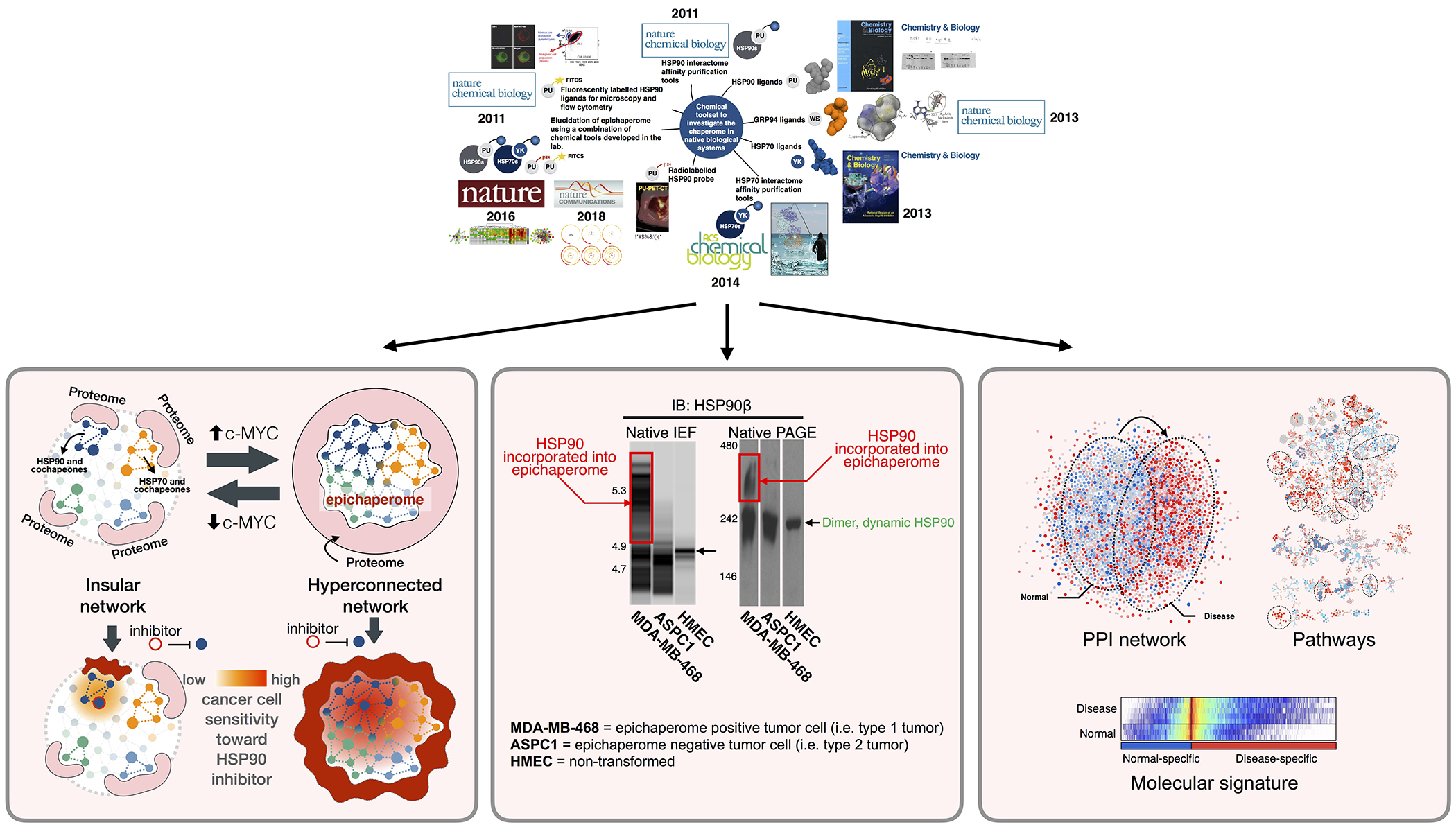Rodina A, Xu C, Digwal CS, Joshi S, Patel Y, Santhaseela AR, Bay S, Merugu S, Alam A, Yan P, Yang C, Roychowdhury T, Panchal P, Shrestha L, Kang Y, Sharma S, Almodovar J, Corben A, Alpaugh ML, Modi S, Guzman ML, Fei T, Taldone T, Ginsberg SD, Erdjument-Bromage H, Neubert TA, Manova-Todorova K, Tsou MB, Young JC, Wang T, Chiosis G. Systems-level analyses of protein-protein interaction network dysfunctions via epichaperomics identify cancer-specific mechanisms of stress adaptation. Nat Commun. 2023;14(1):3742. doi: 10.1038/s41467-023-39241-7. https://www.nature.com/articles/s41467-023-39241-7
Ginsberg SD, Sharma S, Norton L, Chiosis G. Targeting stressor-induced dysfunctions in protein-protein interaction networks via epichaperomes. Trends Pharmacol Sci. 2023;44(1):20-33. doi: 10.1016/j.tips.2022.10.006. https://pubmed.ncbi.nlm.nih.gov/36414432/
Joshi S, Gomes ED, Wang T, Corben A, Taldone T, Gandu S, Xu C, Sharma S, Buddaseth S, Yan P, Chan LYL, Gokce A, Rajasekhar VK, Shrestha L, Panchal P, Almodovar J, Digwal CS, Rodina A, Merugu S, Pillarsetty N, Miclea V, Peter RI, Wang W, Ginsberg SD, Tang L, Mattar M, de Stanchina E, Yu KH, Lowery M, Grbovic-Huezo O, O’Reilly EM, Janjigian Y, Healey JH, Jarnagin WR, Allen PJ, Sander C, Erdjument-Bromage H, Neubert TA, Leach SD, Chiosis G. Pharmacologically controlling protein-protein interactions through epichaperomes for therapeutic vulnerability in cancer. Commun Biol. 2021 Nov 25;4(1):1333. doi: 10.1038/s42003-021-02842-3.
Inda MC, Joshi S, Wang T, Bolaender A, Gandu S, Koren III J, Che AY, Taldone T, Yan P, Sun W, Uddin M, Panchal P, Riolo M, Shah S, Barlas A, Xu K, Chan LYL, Gruzinova A, Kishinevsky S, Studer L,Fossati V, Noggle SA, White JR, de Stanchina E, Sequeira S, Anthoney KH, Steele JW, Manova-Todorova K,Patil S, Dunphy MP, Pillarsetty N, Pereira AC, Erdjument-Bromage H, Neubert TA, Rodina A, Ginsberg SD, De Marco Garcia N, Luo W, Chiosis G. The epichaperome is a propagator of toxic hippocampal stress and leads to protein connectivity-based dysfunction. Nature Commun. 2020 Jan 16;11(1):319.
Pillarsetty N, Jhaveri K, Taldone T, Caldas-Lopes E, Punzalan B, Joshi S, Bolaender A, Uddin MM, Rodina A, Yan P, Ku A, Ku T, Shah SK, Lyashchenko S, Burnazi E, Wang T, Lecomte N, Janjigian Y, Younes A, Batlevi CW, Guzman ML, Roboz GJ, Koziorowski J, Zanzonico P, Alpaugh ML, Corben A, Modi S, Norton L, Larson SM, Lewis JS, Chiosis G*, Gerecitano JF, Dunphy MPS. (*lead contact) Paradigms for Precision Medicine in Epichaperome Cancer Therapy. Cancer Cell. 2019 Nov 11;36(5):559-573.e7. doi: 10.1016/j.ccell.2019.09.007. Epub 2019 Oct 24.
Joshi S, Wang T, Araujo TLS, Sharma S, Brodsky JL, Chiosis G. Adapting to stress - chaperome networks in cancer. Nat Rev Cancer. 2018;18(9):562-75. PMCID: PMC6108944. Altmetric 352. PubMed
-
Featured on NBC, ABC, Fox, PR newswire etc, Altmetric 362
Rodina A, Wang T, Yan P, Gomes ED, Dunphy MP, Pillarsetty N, Koren J, Gerecitano JF, Taldone T, Zong H, Caldas-Lopes E, Alpaugh M, Corben A, Riolo M, Beattie B, Pressl C, Peter RI, Xu C, Trondl R, Patel HJ, Shimizu F, Bolaender A, Yang C, Panchal P, Farooq MF, Kishinevsky S, Modi S, Lin O, Chu F, Patil S, Erdjument-Bromage H, Zanzonico P, Hudis C, Studer L, Roboz GJ, Cesarman E, Cerchietti L, Levine R, Melnick A, Larson SM, Lewis JS, Guzman ML, Chiosis G. The epichaperome is an integrated chaperome network that facilitates tumour survival. Nature. 2016;538(7625):397-401. PMCID: PMC5283383. Altmetric 439. PubMed
Featured in:
-
Kai Bartkowiak & Klaus Pantel. Cancer: A shocking protein complex. Nature (2016), News&Views, doi:10.1038/nature19476
-
Stu Borman. Heat-shock protein complexes serve as cancer drug targets. ‘Epichaperomes’ that form in some cancer cells might enable selective therapies. CE&N News, Volume 94 Issue 40, pp. 10-11 Science & Technology Concentrates; October 10, 2016
-
Andrew P. Han. Assays for Heat Shock Protein Complexes Could Serve as Companion Dx for Inhibitor Drugs. GenomeWeb, Proteomics & Protein Research Oct 10, 2016
-
Anna Dart. Networking: a survival guide. Nature Reviews Cancer | Published online 11 Nov 2016; doi:10.1038/nrc.2016.125
-
Heidi A. Dahlmann. Chaperome Complexes Influence Tumor Survival. ACS Chem. Biol., 2016, 11 (11), pp 2941–2943. DOI: 10.1021/acschembio.6b00969
-
Philipp Markolin. How a complex network of proteins contributes to cancer survival. https://medium.com/advances-in-biological-science/how-a-complex-network…
-
https://f1000.com/prime/726802982
-
https://www.mskcc.org/blog/experimental-cancer-drug-developed-msk-leads…
-
http://www.samustherapeutics.com/
-
https://www.prnewswire.com/news-releases/samus-therapeutics-announces-l…
Kishinevsky S, Wang T, Rodina A, Chung SY, Xu C, Philip J, Taldone T, Joshi S, Alpaugh ML, Bolaender A, Gutbier S, Sandhu D, Fattahi F, Zimmer B, Shah SK, Chang E, Inda C, Koren J, Saurat NG, Leist M, Gross SS, Seshan VE, Klein C, Tomishima MJ, Erdjument-Bromage H, Neubert TA, Henrickson RC, Chiosis G, Studer L. HSP90-incorporating chaperome networks as biosensor for disease-related pathways in patient-specific midbrain dopamine neurons. Nature Communications. 2018;9(1):4345.





